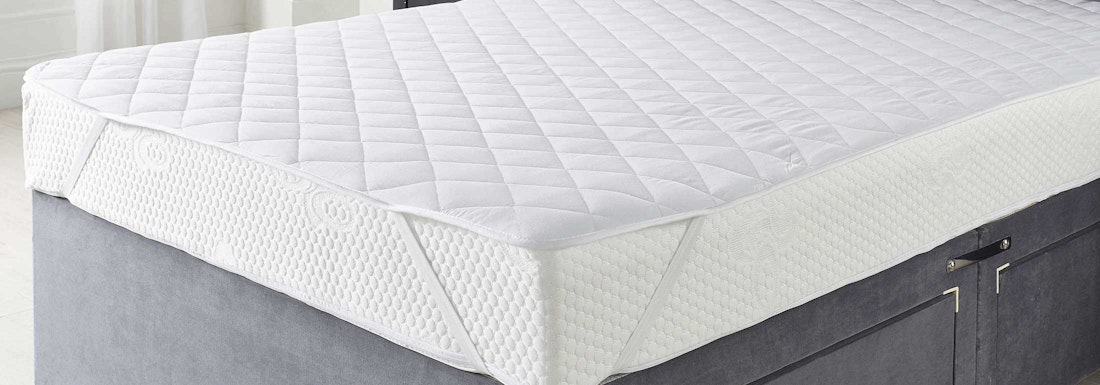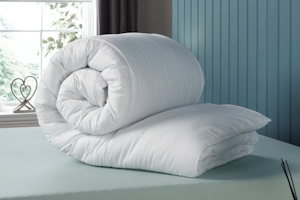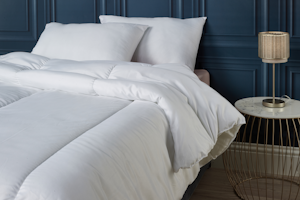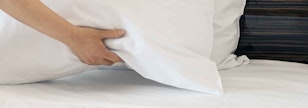20 Mar 2025

Easy Ways to Keep Mattress from Sliding
27 Sep 2023
A mattress that constantly slides around on its bed frame can be a source of frustration and discomfort for many people. Not only can it be an annoyance, but it can also negatively impact the quality of sleep we receive each night. In response to this common issue, a variety of solutions have been developed that are both simple to implement and highly effective in keeping your mattress firmly in place.
Understanding the factors that cause mattress movement is essential in addressing the issue. The type of bed frame, the materials used, and the condition of the mattress all play a role in its stability. Thankfully, there are several easy and inexpensive options, such as non-slip mattress pads, rubber matting, and DIY solutions that can drastically improve the situation, ensuring a more peaceful and secure sleep experience.
Key Takeaways
- It's essential to comprehend the factors causing the mattress to move for effectively preventing it from sliding.
- Non-slip mattress pads and rubber matting are affordable and readily available solutions to mattress movement.
- DIY solutions and regular maintenance can also provide excellent results in keeping mattresses securely in place.
Understanding Mattress Movement
Mattress movement can be a common issue faced by many people, disrupting sleep and causing discomfort. A mattress that slides off its base or frame can lead to a lack of proper support, impacting the quality of sleep. There are several factors that can cause a mattress to move, such as dust accumulation, the type of foundation it rests on, and the materials used in its construction.
One of the leading reasons behind mattress movement is dust and debris accumulated beneath the mattress. Over time, this build-up creates a slippery surface between the mattress and its support, resulting in the slipping and sliding of the mattress. Regularly vacuuming under the mattress using a brush attachment can help address this issue.
Another contributing factor to mattress movement is the foundation it rests on. A stable and supportive base is essential for preventing mattress slippage. Ensure that the bed frame or box spring is in good condition and well-fitted to the mattress size, as any inconsistency may lead to movement.
Additionally, the materials used in both the mattress and its support can impact stability. Some materials, such as certain types of foam, can be more susceptible to sliding than others, like traditional innerspring mattresses. When selecting a mattress, consider its compatibility with the chosen support system to minimise the chances of movement.
Lastly, the presence or absence of proper padding can also influence how well a mattress stays in place. Utilising non-slip mattress pads or rubber matting can provide additional grip between the mattress and its support, helping to keep it in position.
In summary, understanding the factors that contribute to mattress movement is crucial in addressing the issue. Regular cleaning, ensuring a supportive base, selecting compatible materials, and using non-slip pads can all assist in keeping a mattress from sliding and ensuring a comfortable sleep.
Non-slip Mattress Pads
What are They
Non-slip mattress pads are specially designed bedding accessories that help prevent mattresses from sliding on bed frames or foundations. They are made from materials that create enough friction between the mattress and the frame or foundation, keeping the mattress secure and stable. These mattress pads come in various sizes, primarily designed to match standard mattress sizes like twin, king, queen, or full.
Why They Work
The effectiveness of non-slip mattress pads lies in their material properties, which usually includes a textured, grippy surface. This surface creates resistance against the mattress and the bed frame or foundation, keeping the mattress from moving out of place. The pad's durability and compatibility with various mattress sizes make it an ideal solution for keeping mattresses from sliding. Using a non-slip mattress pad can also help prolong the lifespan of your mattress by preventing it from shifting, thus reducing the chances of uneven wear and tear.
Rubber Matting
Advantages
Rubber matting is an effective solution to prevent your mattress from sliding off the bed frame. When placed between the mattress and the frame, it adds friction, keeping the mattress stable and in position. Rubber mats are inexpensive and easily available in most DIY or home improvement stores.
Using rubber matting has several advantages, including:
- Durability: Rubber mats are sturdy and long-lasting, so they provide an effective barrier between the mattress and frame for a more extended period.
- Versatility: They can be used with various bed types, including box springs, platform beds, and adjustable beds.
- Ease of installation: Rubber mats are easy to install; simply place the mat between the mattress and the frame without any need for tools or professional assistance.
Selection Guide
When choosing rubber mats for your bed, consider the following factors to ensure they provide maximum grip and prevent your mattress from sliding:
- Size: Select a mat that is slightly smaller than the size of your mattress to avoid the mat from being visible and interfering with the aesthetics of your bedroom.
- Thickness: A thicker mat may provide better grip, so consider thickness when making a purchase. However, avoid mats that are too thick, as they may reduce the overall comfort level of the mattress.
- Material: Look for rubber mats that are made with high-quality, grippy material to increase the effectiveness o their non-slip nature. Some mats may also feature rough textures or dimples to further enhance the grip.
- Caring and maintenance: Ensure that your chosen rubber mat is easy to clean and maintain to prolong its effectiveness.
Remember to follow the manufacturer's instructions when installing the rubber mat and periodically check its effectiveness to ensure the mattress remains in place.
DIY Solutions
Velcro Strips
One effective method to prevent a mattress from sliding is by using Velcro strips. Attach one side of the Velcro to the mattress and the other side to the bed frame. This will create a secure bond, keeping the mattress in place. Velcro strips are easy to apply and can be easily removed if necessary. They are often found in a variety of sizes and strengths to suit any bed size.
Non-skid Mats
Another easy solution to keep a mattress from sliding is the use of non-skid mats. These mats can be placed between the mattress and the bed frame, providing additional friction to prevent movement. Common non-skid mats include rubber matting, rug pad grippers, and even yoga mats. These options are widely available, relatively inexpensive, and can be cut to fit the precise size of your bed.
Double-sided Tape
Lastly, double-sided tape can be an effective method for keeping your mattress in place. Apply the tape to the bed frame – ensuring the surface is clean and dust-free – then press your mattress firmly onto the tape. This will create a strong bond between the mattress and the bed frame, helping to prevent any unwanted sliding. Keep in mind that double-sided tape may leave a residue on your bed frame, so it's important to test it in an inconspicuous area first.
Preventing Movement at Source
Ensuring Correct Bed Frame Size
To minimise mattress movement, it is crucial to ensure the bed frame size matches the mattress size. A mattress that is either too big or too small for the bed frame will likely slide around more easily. If possible, measure the dimensions of both the bed frame and the mattress before purchasing to ensure they fit together perfectly. A snug fit between the mattress and the bed frame can significantly reduce the chances of the mattress sliding around.
Checking Mattress Base
Another essential factor in preventing mattress movement is checking the mattress base. A clean and dust-free base can increase friction, making it more difficult for the mattress to slide. Vacuum the area underneath the mattress regularly to keep it free from dust and debris.
It is also important to consider the material used in the base. Some materials, such as metal, are more prone to allowing mattresses to slide. Using a non-slip pad or rubber mat between the mattress and the base can help keep the mattress in place. These non-slip pads or mats can be found in most DIY stores and are an inexpensive solution to the problem. Additionally, placing a non-slip mattress pad on top of the base can further improve stability and keep the mattress from sliding.
By ensuring the correct bed frame size and checking the mattress base, one can reduce mattress movement and create a more comfortable and stable sleeping environment.
Regular Maintenance
Periodic Adjustments
One effective method for preventing a mattress from sliding is to periodically adjust its position on the bed frame. Over time, factors such as daily use and shifting bed sheets can cause the mattress to slide or shift, resulting in an unstable sleeping surface. By making small adjustments and ensuring the mattress is aligned with the bed frame, the risk of slippage can be reduced.
To maintain secure positioning, regularly tighten the bolts and screws on the bed frame and headboard. A secure foundation will reduce the likelihood of the mattress moving out of place. Additionally, make certain that the bed legs are level and stable on the floor. Uneven flooring can contribute to a shifting mattress, so using adjustable leg supports or placing a wedge under an uneven leg can help maintain stability.
Condition Checks
Performing regular checks on the condition of your mattress and bed frame is another strategy for keeping the mattress from sliding. Over time, materials can wear down, such as the fabric of the mattress that might lose its grip with the bed frame, or the slats that provide support underneath.
Inspect the mattress for wear and tear, watching for signs of reduced friction between the bed frame and the mattress, which may contribute to sliding. If the mattress fabric shows noticeable signs of wear, consider using a non-slip mattress cover to increase friction and keep the mattress in place.
Similarly, checking the condition of the bed frame's slats or box spring is essential. Ensure they are secure and in proper condition, providing even support to the mattress and preventing movement. If they appear weak or damaged, replacement may be necessary to maintain optimal stability and prevent the mattress from sliding.
In summary, regular maintenance through periodic adjustments and condition checks is an effective approach to keep a mattress from sliding, ensuring a comfortable and stable sleeping environment.


